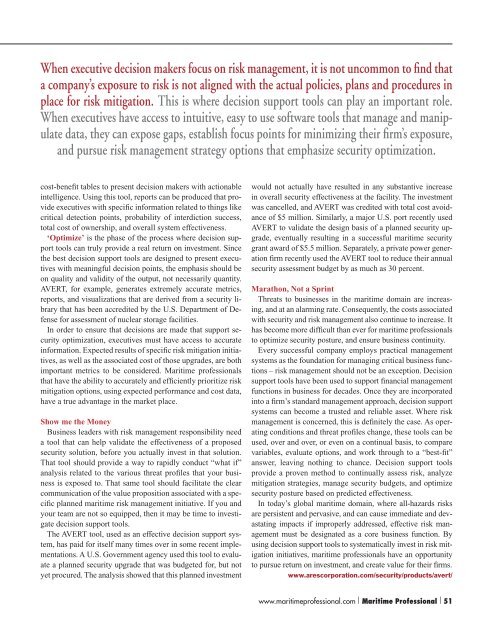1fjzeJ0
1fjzeJ0
1fjzeJ0
You also want an ePaper? Increase the reach of your titles
YUMPU automatically turns print PDFs into web optimized ePapers that Google loves.
When executive decision makers focus on risk management, it is not uncommon to find thata company’s exposure to risk is not aligned with the actual policies, plans and procedures inplace for risk mitigation. This is where decision support tools can play an important role.When executives have access to intuitive, easy to use software tools that manage and manipulatedata, they can expose gaps, establish focus points for minimizing their firm’s exposure,and pursue risk management strategy options that emphasize security optimization.cost-benefit tables to present decision makers with actionableintelligence. Using this tool, reports can be produced that provideexecutives with specific information related to things likecritical detection points, probability of interdiction success,total cost of ownership, and overall system effectiveness.‘Optimize’ is the phase of the process where decision supporttools can truly provide a real return on investment. Sincethe best decision support tools are designed to present executiveswith meaningful decision points, the emphasis should beon quality and validity of the output, not necessarily quantity.AVERT, for example, generates extremely accurate metrics,reports, and visualizations that are derived from a security librarythat has been accredited by the U.S. Department of Defensefor assessment of nuclear storage facilities.In order to ensure that decisions are made that support securityoptimization, executives must have access to accurateinformation. Expected results of specific risk mitigation initiatives,as well as the associated cost of those upgrades, are bothimportant metrics to be considered. Maritime professionalsthat have the ability to accurately and efficiently prioritize riskmitigation options, using expected performance and cost data,have a true advantage in the market place.Show me the MoneyBusiness leaders with risk management responsibility needa tool that can help validate the effectiveness of a proposedsecurity solution, before you actually invest in that solution.That tool should provide a way to rapidly conduct “what if”analysis related to the various threat profiles that your businessis exposed to. That same tool should facilitate the clearcommunication of the value proposition associated with a specificplanned maritime risk management initiative. If you andyour team are not so equipped, then it may be time to investigatedecision support tools.The AVERT tool, used as an effective decision support system,has paid for itself many times over in some recent implementations.A U.S. Government agency used this tool to evaluatea planned security upgrade that was budgeted for, but notyet procured. The analysis showed that this planned investmentwould not actually have resulted in any substantive increasein overall security effectiveness at the facility. The investmentwas cancelled, and AVERT was credited with total cost avoidanceof $5 million. Similarly, a major U.S. port recently usedAVERT to validate the design basis of a planned security upgrade,eventually resulting in a successful maritime securitygrant award of $5.5 million. Separately, a private power generationfirm recently used the AVERT tool to reduce their annualsecurity assessment budget by as much as 30 percent.Marathon, Not a SprintThreats to businesses in the maritime domain are increasing,and at an alarming rate. Consequently, the costs associatedwith security and risk management also continue to increase. Ithas become more difficult than ever for maritime professionalsto optimize security posture, and ensure business continuity.Every successful company employs practical managementsystems as the foundation for managing critical business functions– risk management should not be an exception. Decisionsupport tools have been used to support financial managementfunctions in business for decades. Once they are incorporatedinto a firm’s standard management approach, decision supportsystems can become a trusted and reliable asset. Where riskmanagement is concerned, this is definitely the case. As operatingconditions and threat profiles change, these tools can beused, over and over, or even on a continual basis, to comparevariables, evaluate options, and work through to a “best-fit”answer, leaving nothing to chance. Decision support toolsprovide a proven method to continually assess risk, analyzemitigation strategies, manage security budgets, and optimizesecurity posture based on predicted effectiveness.In today’s global maritime domain, where all-hazards risksare persistent and pervasive, and can cause immediate and devastatingimpacts if improperly addressed, effective risk managementmust be designated as a core business function. Byusing decision support tools to systematically invest in risk mitigationinitiatives, maritime professionals have an opportunityto pursue return on investment, and create value for their firms.www.arescorporation.com/security/products/avert/www.maritimeprofessional.com | Maritime Professional | 51


